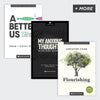
Perhaps it’s not surprising that American Christians are increasingly less inclined to join or even to attend church on a regular basis. In the United States, it can feel countercultural to expect people to identify with and commit to a local church family. Historically and throughout the world, however, belonging to a broader community is the norm—a private faith and disconnect from a steady community would be unimaginable. So, we face a unique challenge and a tremendous opportunity when it comes to introducing people to deep, meaningful, and transformative relationships.
Take a look at two realities for disciple-making in our context revealed by the most recent State of Theology results:
“Given the Bible’s assumption that those who claim to follow Christ will also join a local body of believers (1 Cor. 5:12–13; 11:18; 1 Tim. 3:1–13; 5:9; 1 Peter 5:1–5), it may be surprising that only 68 percent of evangelicals view church membership as obligatory. This may indicate the influence of an individualistic worldview within the church, as well as challenges posed by the COVID-19 pandemic and ever-increasing access to viewing various churches’ services via the internet.” SOT>
Furthermore, the majority of Christians believe that “worshiping alone or with one’s family is a valid replacement for regularly attending church.” SOT>
While most evangelicals still believe that church membership is important, they also consider regular attendance to be optional. So, how do we engage people with the blessing of biblical community?
Circles Not (Just) Rows
You’re probably familiar with the small group cliché: “circles not rows.” Or not just rows. The idea is that we need to help people move beyond the ease of slipping in and out of worship services (sitting in “rows” facing the platform in a larger setting) and into personal relationships (gathering in smaller groups where they can know and be known by other people, “circling up” for conversation, study, prayer, meals, etc.).
We see in Jesus’ own ministry and in the descriptions of the early church how disciple-making included both larger and smaller settings. Jesus taught, fed, and healed multitudes (Luke 5:15), a committed group of disciples followed and were sent out by Jesus (Luke 10:1), He intentionally spent more time with a smaller group of Twelve (Luke 6:13), and finally, Jesus had a group of three disciples who are described as experiencing even closer community with Christ (Luke 8:51, 9:28). Likewise, the early Church is described as continually meeting in the temple courts and gathering in homes (Acts 2:41–47) and as they grew in number, they identified people to help make sure individuals weren’t being overlooked and neglected by the church community (Acts 6:1–7).
As more disciples were made and the church grew larger, smaller groups were put into place to care for Christians on a more personal level.
What’s Your Plan?
People who stay engaged with the local church, especially younger generations as they age, are those who have meaningful relationships within the church community and a sense of how their faith applies to life beyond the church walls. Barna>
Knowing that our cultural context is increasingly less committed to attending and joining a church, what is your plan for discipleship? What vision are you casting for your people and what clear next step is provided as a proven and effective way of facilitating community? As noted in last week’s post, healthy and holistic discipleship requires a balance of “organization” and “organic” relationships. Churches benefit from a disciple-making plan that invites people into some kind of small group community and then sets them up for ongoing success.
I want to offer you at least one option that’s been fruitful in a wide range of cultures, churches, and communities. For over a decade now, Rooted has proven to be a clear and effective entry point for moving people into groups for the sake of an ongoing discipleship journey.
Statistics prove that people involved in groups are twice as likely to be engaged with their faith, are more likely to go to church at least four times a month (79%), and read the Bible daily (28%). The overwhelming majority (90%) of people who participate in the 10-week Rooted experience go on to engage in group life—whatever that looks like within their own local church context.
That kind of fruit is worth checking out! The Rooted Network offers free samples of Rooted and invites you to a free webinar for what Rooted might look like within your own discipleship strategy. How do you draw people into your discipleship ecosystem and move them forward on a clear pathway toward spiritual growth and maturity? Rooted is a great option for experiencing and launching new and healthy groups. Let me invite you to consider the following:
- Download a free sample of Rooted. (Here)
- Register for our next What is Rooted? webinar. (Here)
- Speak 1-on-1 with a Rooted Network coach about your discipleship strategy. (Here)
Then, once you get people into groups, how do they continue to grow? Sign up for our email list below to receive October’s free resource: My Discipleship Pathway and Ecosystem, a simple tool for mapping out your own disciple-making plans.
Continue reading our other posts in this series of Building a Discipleship Ecosystem.
State of Theology 2022 – We Need a New Discipleship Plan
Pathway and Ecosystem: Two Views of Discipleship
Identifying the Elements of a Discipleship Ecosystem








